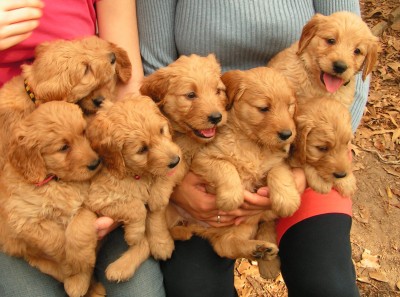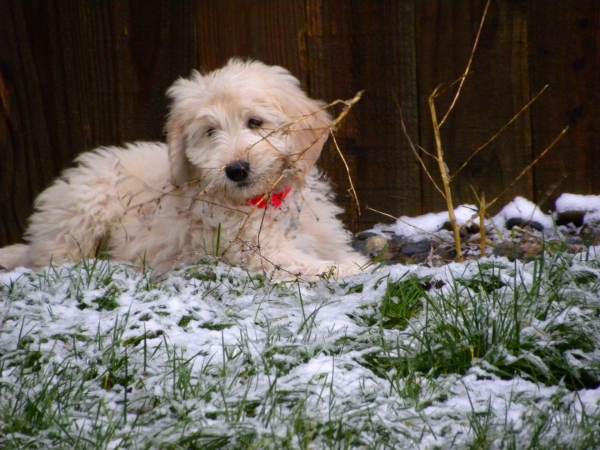


A Goldendoodle is a Golden Retriever and Poodle cross.  Goldendoodles, also called Golden Poos, Goldie Poos, or Groodles, have been bred in North America and Australia since the early to mid-1990’s.
For some strange reason, many goldendoodles actually grow larger than either their golden retriever or standard poodle parents!
The Goldendoodle is a hybrid cross of a Golden Retriever and a Poodle. The exact date of the first goldendoodle is unknown as a handful of breeders emerged in the late 1990’s marketing this new breed. The idea was no doubt inspired by the creation of the Labradoodle and its success as a compatible dog for many people who experience mild allergies to dogs. Several different names were being used to describe the breed such as GoldenPoos, GoldiePoos, and PoodleReivers, but the name “Goldendoodle” was the one that stuck. The gorgeous low to no shedding coats were attracting those who loved the temperament of the Golden Retriever, but detested the amount of hair left behind and/or the allergy issues it presented.
The term ‘Goldendoodle’ appeared soon after the introduction of the Labradoodle by Wally Conron. The earliest known use of the name ‘Goldendoodle’ comes from the Neelands family in the U.S.A in 1992.  The family started calling their dog, Sugar, a ‘goldendoodle’  in response to a question from a passerby who asked “is that a labradoodle?â€.  They replied, “No, it’s a goldendoodleâ€, and have referred to her as such ever since.
The publicʼs immediate adoration of the standard Goldendoodle (a standard Poodle crossed with a Golden Retriever) has grown to epic proportions as “Designer Dogs” became the latest fad. The key word here is “fad”, meaning something that causes lots of attention, but soon loses its appeal. The Goldendoodleʼs appeal hasnʼt faded, but instead has continued to grow.
In keeping up with celebrity trends, the labradoodle has always been a top pick for the pooches of the rich and famous however the goldendoodle is catching up in popularity among the celebs.
Most of the cross breeds include poodles because they are intelligent and their woolly coat sheds very little hair. This makes them less likely to aggravate allergies. Plus their just so dang cute!
This love affair prompted the creation of the first litter of Mini Goldendoodles (a mini Poodle crossed with a Golden Retriever). The first litter arrived on January 11, 2002. These first mini Goldendoodles attracted attention everywhere they went and the number of requests for more were too many to accomodate by a single breeder. As word spread, more breeders of standard Goldendoodles began producing litters of mini Goldendoodles to try to satisfy the publicʼs demand for this new size that was perfect for apartment and city living.
Goldendoodles are extremely social, outgoing, non-aggressive dogs that thrive on human companionship. They have a great desire to please and to learn. Coupled with the low to non-shedding coats, this temperament has proven to make Goldendoodles perfect candidates for service work.
The Goldendoodle is a new breed in the grand scheme of breed development. Most AKC recognized breeds took decades to develop and even more decades to earn AKC recognition. It seems that breeders are mixed in their ideas and goals about working towards “purebred” status with the AKC.
The Goldendoodle’s ancestry along both parent lines is as hunters and water dogs. The physical appearance of the Goldendoodle runs anywhere from a shaggy-looking retriever to a curl-relaxed poodle, but usually it falls somewhere in between. The length of the coat when left unclipped grows to about 4-8 inches. The color of the coat can be cream, gold, apricot, chocolate, gray and black. Most Goldendoodles have a Standard Poodle as a parent, and are standard sized. Those with a miniature Poodle as a parent, are about 25-50 pounds and are called miniature or medium Goldendoodles.
Many poodle crosses inherit the fur qualities of the poodle, but not the texture. This means that most don’t shed, or shed lightly, and may not produce an allergic reaction. Most Goldendoodles are light to non-shedding, and most live easily with families with MILD allergies. The F1b Generation Goldendoodle is the best generation for severe allergy sufferes.
Goldendoodles were first deliberately bred in North America as a larger version of the popular Cockapoo around the mid 1990s. Their non/light shedding coats and ability to live with families with allergies has made them very popular companions.
The AKC has ranked dogs according to popularity in North America.  The Labrador Retriever heads the list at first place, with Golden Retriever ranked 4th and the Poodle ranked 5th  out of 148 breeds.  In his book “The Intelligence of Dogs†Stanley Coren ranks 79 dog breeds in order of intelligence.  Poodles scored 2nd,  Golden Retrievers were 4th and Labrador Retreiver ranked 7th.
Goldendoodles are an intelligent and obedient family companion. They are everybody’s friend and devoted to their family. They are friendly towards children, other dogs and pets, and easy with strangers. They are social dogs, happiest when with people. Goldendoodles are likely to get into mischief and develop behavior problems if they spend most of their lives alone. Their intelligence, eagerness to please, and love of learning make them very easy to train. They are medium-to large sized family dogs with easy dispositions.
The size of the Goldendoodle depends on its parentage. Â A general rule of thumb is to add both the parents weights together and divide by 2 to get an average adult weight on the puppies. Â Within any litter there may be puppies that fall above or below the projected adult weights.
We breed a Medium size Goldendoodle with a size range between 40-55 pounds full grown.
Some standard Goldendoodles have grown to more than 100 pounds.
(Since this is a hybrid and not a “standardized breed” it is important to note that specific sizes cannot be guaranteed for grown dog. Buyers must be willing to accept a puppy with the grown weight and heights being only estimates, as there is the possibility for puppies to be more or less than the estimated weight and height ranges above.)
Goldendoodles require a moderate amount of exercise and their coats are generally low maintenance. They can live in the city or on a farm. They are social dogs and they are happiest when they are with people.
About 12-15 years
Goldendoodles need regular grooming and coat care as all dogs do but for most, the maintenance is minimal. For short to medium length coats, you will need very little care. Regular washings and brushings will do just fine. These are usually low allergen risk and safe for most families with mild allergies.
If you have a Goldendoodle with a longer, curlier coat like a poodle, it may require more grooming care. Many owners enjoy styling the coat of their longer haired Goldendoodles and if properly cared for, the hair can grow all the way to the ground. Regardless of which type you have, the hair around the eyes and the genitals should also be neatly clipped and regular brushing will keep the coat shiny all over.

A Goldendoodle can actually be many colors with all sorts of markings. Why? Because the Poodle has such a wide variety of color genes in its genetic make-up. Goldendoodles can range from white, light apricot, dark apricot, cream, red, chocolate, chocolate phantom, silver phantom, silver frost, silver and black. Goldendoodles can also be any of the above colors and have white or tan markings. Goldendoodles can be tri-color (silver/tan/white, silver/white/tan) and Goldendoodles can be of parti-color with any combination of colors and markings that would make them of parti-coloration. These are very rare in the F1 generation but can be seen in the F1b generations.
There are a few different ways breeders are producing Goldendoodles.
*We currently breed F1 and F1b Goldendoodle and Labradoodles*
The first generation (F1) standard size Goldendoodle was the first to be bred. It is the product of a standard Poodle crossed with a Golden Retriever.  Most first generation Goldendoodles either don’t shed or shed lightly, and are compatible for most families with mild allergies.
The back cross (F1b) Goldendoodle is produced by crossing an F1  Goldendoodle with a  Poodle. These dogs will have a higher success rate for non-shedding, and are recommended for families with moderate to severe allergies.
Grading Scheme according to The Goldendoodle association of America–
*F1B bred to poodle (not accepted)
*Goldendoodle to Golden Retriever (not accepted)
A new generation is accomplished by increasing by one from the lowest generation in a breeding pair.
An F1 crossed with any generation will only produce an F2 (ie: F1xF4 still equals an F2).  Any B generation counts as one up for grading purposes (ie:  F1B counts as an F2). A Poodle cannot be added after the F1B generation.  A Golden Retriever cannot be added after the F1 generation.
The purpose of breeding within this format is to maintain a balance of retriever and poodle qualities in addition to the low to no shedding qualities which will be compromised if breeding outside this scheme.
According to the data below both the Golden Retriever and the Poodle rank extremely HIGH when it comes to general popularity and intelligence and mixing the two.. gives us the best of both breeds according to many a doodle owner and breeder.
Highly Popular: The AKC has ranked dogs according to popularity in North America.
The Golden Retriever ranked 4th and the Poodle ranked 5th, out of 148 breeds in popularity.
Highly Intelligence: In the book “The Intelligence of Dogs†by Stanley Coren he ranks 79 dog breeds in order of  working and obedience abilities – intelligence.
To View the whole list…click the links below

Click here to view the entire list 0f 79 dogs ranked for Working/Obedience Intelligence